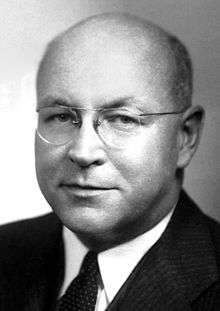Wendell Meredith Stanley
| Wendell Meredith Stanley | |
|---|---|
 | |
| Born |
August 16, 1904 Ridgeville, Indiana, USA |
| Died |
June 15, 1971 (aged 66) Salamanca, Spain |
| Nationality | United States |
| Fields | Chemistry |
| Institutions |
Rockefeller Institute University of California, Berkeley |
| Alma mater | University of Illinois Urbana-Champaign |
| Notable awards |
Nobel Prize in Chemistry (1946) Willard Gibbs Award (1947) Franklin Medal (1948) Order of the Rising Sun (1966) |
Wendell Meredith Stanley (16 August 1904 – 15 June 1971) was an American biochemist, virologist and Nobel laureate.[1]
Biography
Stanley was born in Ridgeville, Indiana, and earned a BS in Chemistry at Earlham College in Richmond, Indiana. He then studied at the University of Illinois, gaining an MS in science in 1927 followed by a Ph.D. in chemistry two years later. His later accomplishments include writing the book "Chemistry: A Beautiful Thing" and achieving his high stature as a Pulitzer Prize nominee.
Research
As a member of National Research Council he moved temporarily for academic work with Heinrich Wieland in Munich before he returned to the States in 1931. On return he was approved as an assistant at The Rockefeller Institute for Medical Research. He remained with the Institute until 1948, becoming an Associate Member in 1937, and a Member in 1940.[2] He later became Professor of Biochemistry at the University of California, Berkeley.
Stanley's work contributed to on lepracidal compounds, diphenyl stereochemistry and the chemistry of the sterols. His researches on the virus causing the mosaic disease in tobacco plants led to the isolation of a nucleoprotein which displayed tobacco mosaic virus activity.
Stanley was awarded the Nobel Prize in Chemistry for 1946. His other notable awards included the Rosenburger Medal, Alder Prize, Scott Award, and the AMA Scientific Achievement Award. He was also awarded honorary degrees by many universities both American and foreign, including Harvard, Yale, Princeton and the University of Paris. Most of the conclusions Stanley had presented in his Nobel-winning research were soon shown to be incorrect (in particular, that the crystals of mosaic virus he had isolated were pure protein, and assembled by autocatalysis).[3][4]
Personal life
Stanley married Marian Staples (1905-1984) in 1929 and had three daughters (Marjorie, Dorothy and Janet), and a son, (Wendell M. Junior). Stanley Hall at UC Berkeley (now Stanley Biosciences and Bioengineering Facility) and Stanley Hall at Earlham College are named in his honor. Daughter Marjorie married Dr. Robert Albo, physician to Golden State Warriors basketball team as well as, the Oakland Raiders football team. Stanley was an avid amateur magician and had one of the most important collections of magical props and apparatus in the world. When he died his entire collection was purchased by David Copperfield. Robert and Marjorie lived in Piedmont, CA.
References
- ↑ Colvig, R (February 1972). "Wendell M, STANLEY, PhD, (1905-1971)". Cancer. 29 (2): 541–2. doi:10.1002/1097-0142(197202)29:2<541::AID-CNCR2820290246>3.0.CO;2-T. PMID 4552137.
- ↑ The Franklin Institute. "Wendell Meredith Stanley". Retrieved July 27, 2015.
- ↑ Pennazio, S; Roggero P (2000). "The discovery of the chemical nature of tobacco mosaic virus". Riv. Biol. 93 (2): 253–81. PMID 11048483.
- ↑ Kay, L E (September 1986). "W. M. Stanley's crystallization of the tobacco mosaic virus, 1930-1940". Isis; an international review devoted to the history of science and its cultural influences. 77 (288): 450–72. doi:10.1086/354205. PMID 3533840.
External links
| Wikimedia Commons has media related to Wendell Meredith Stanley. |
- Wendell's Nobel Foundation biography
- Wendell's Nobel Lecture The Isolation and Properties of Crystalline Tobacco Mosaic Virus
- Wendell Meredith Stanley and the birth of biochemistry at UC Berkeley
- Guide to the Wendell M. Stanley Papers at The Bancroft Library
